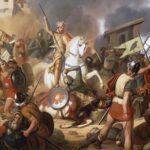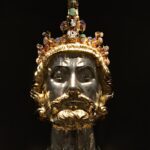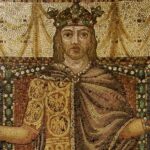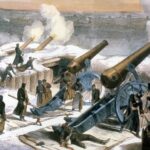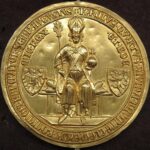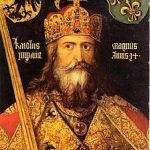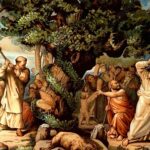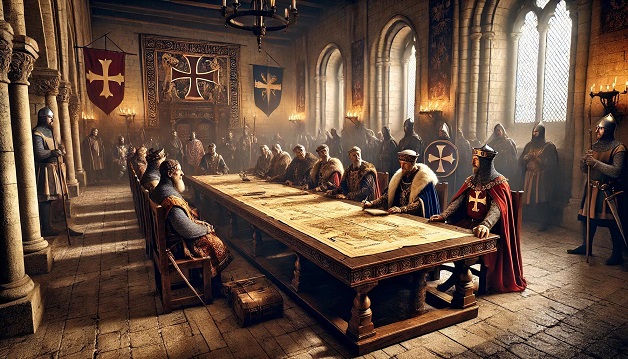
It’s 843 CE. Three royal brothers sit down at a table in Verdun-sur-Meuse, a quiet town in what is now northeastern France. The empire they’ve inherited—the one forged by their grandfather, Charlemagne—is crumbling under the weight of ambition and civil war. The decision they make will change the course of European history.
This is the story of the Treaty of Verdun—a treaty born not from diplomacy, but from bloodshed, betrayal, and the brutal realities of dynastic inheritance. It marked the first formal split of the Carolingian Empire and laid the groundwork for modern Europe, especially France and Germany.
The Empire That Couldn’t Stay United
After Charlemagne’s death in 814, his only surviving legitimate son, Louis the Pious, became emperor. But Louis was more monk than monarch. While he tried to maintain unity through Christian virtue and imperial tradition, his rule was marked by conflict—with nobles, with his own sons, and with the very idea of indivisible empire.
Louis had several sons:
- Lothair I (the eldest): Crowned co-emperor, he expected to rule everything.
- Pepin of Aquitaine: Ruled the southwestern lands.
- Louis the German: Governed the eastern territories.
- Charles the Bald: Born later to Louis’s second wife, Judith, and deeply resented by his brothers.
The problem? Carolingian inheritance laws were inconsistent—sometimes primogeniture (eldest inherits all), sometimes partible inheritance (divide it up). Louis kept revising the rules, trying to balance between his sons. It backfired.
Civil War Among Brothers
After Pepin’s early death, the rivalry escalated between Lothair, Louis, and Charles. Their competing claims plunged the empire into a series of civil wars throughout the 830s.
The real turning point came with the Battle of Fontenoy (841)—a gruesome fight where tens of thousands died. Charles and Louis allied to defeat Lothair. In 842, they swore mutual loyalty in the Oaths of Strasbourg, a fascinating historical moment where:
- Charles swore in Old High German (for Louis’s soldiers).
- Louis swore in Old French (for Charles’s).
It’s one of the earliest surviving texts in both languages—and a symbolic moment of growing linguistic division.
What the Treaty Actually Did
In August 843, the brothers finally met in Verdun to make peace.
The treaty divided the empire into three distinct realms:
- West Francia (Charles the Bald): Encompassed most of modern France, including Aquitaine and Neustria. This became the foundation for the Kingdom of France.
- East Francia (Louis the German): Covered the eastern lands—modern-day Germany, Austria, and parts of Switzerland. It became the core of Germany and the future Holy Roman Empire.
- Middle Francia (Lothair I): The oddest slice—stretching from the North Sea through the Low Countries, Lorraine, Burgundy, and down to Rome. Lothair retained the imperial title, but his realm was geographically awkward and politically unstable.
The brothers agreed that this division was permanent. Though they were all still technically “Carolingians,” this was the end of the unified Carolingian Empire.
What Happened Next?
Middle Francia was doomed. After Lothair’s death in 855, it splintered into Lotharingia, Burgundy, and Italy—regions that became disputed zones for centuries.
- Alsace and Lorraine were fought over by France and Germany well into the 20th century.
- The Burgundian kingdoms were absorbed into France, the Holy Roman Empire, or became independent duchies.
Meanwhile, West and East Francia solidified their distinct paths:
- West Francia saw the rise of the Capetian dynasty and evolved into medieval France.
- East Francia became the base of the Ottonian Dynasty, then the Holy Roman Empire.
Cultural and Linguistic Divides
The Treaty of Verdun didn’t just redraw borders—it reflected and reinforced deeper cultural shifts:
- In the west, Gallo-Roman and Frankish cultures fused into what we now call French culture.
- In the east, Germanic traditions remained strong, especially in law, military customs, and governance.
- The central realm, Middle Francia, was more mixed—and that’s part of why it fragmented so easily.
The linguistic legacy is equally significant. The Strasbourg Oaths hinted at it, but over time, Latin evolved into Old French in the west and Old High German in the east. Verdun accelerated this separation.
Why the Treaty Still Matters
- It was the first formal partition of a European empire after Rome.
- It laid the geographic and political groundwork for modern France, Germany, Switzerland, Belgium, and the Netherlands.
- It introduced a precedent of dynastic division that haunted European monarchies.
It also sparked centuries of rivalry between eastern and western Europe, not just politically but culturally, linguistically, and religiously.
Legacy in Law and Diplomacy
The Treaty of Verdun is studied not only by historians but by legal scholars:
- It’s one of the earliest examples of a negotiated, dynastic peace treaty in post-Roman Europe.
- It showed the limitations of personal rule over vast, diverse territories.
- It forced the concept of nationhood into the early medieval imagination, long before the idea of the nation-state was formalized.
Even Napoleon referenced the legacy of Verdun when arguing for unification—or conquest—of European lands. It echoed into the treaties of Westphalia, Vienna, and beyond.
The Treaty of Verdun was a turning point not just for the Carolingians, but for Europe. It showed that even the grandest empires can fracture—and that when they do, the results ripple across centuries.
It’s a story of family feuds, geopolitical shifts, and the slow but steady formation of nations. To learn more about the events surrounding the treaty, explore related articles:
German History Timeline Overview – A concise chronological guide to major events, from early tribes to reunification and modern Germany.
The Rise of the Franks – Discover how this once-small tribe evolved into a dominant political force in early medieval Germany.
Charlemagne and the Carolingian Empire – Understand the political and cultural significance of Charlemagne’s rule across German and European lands.
The Holy Roman Empire – Explore the history of the Holy Roman Empire—its origins, emperors, politics, and role in shaping medieval and modern Germany and Europe.
The Saxons and Their Conversion to Christianity – See how religion and conquest collided as Christianity spread through northern Germanic lands.
Otto the Great and the Rise of the Ottonian Dynasty – Discover how Otto I, known as Otto the Great, solidified imperial power and founded the Ottonian Dynasty, laying the groundwork for the Holy Roman Empire in the 10th century.
Medieval German Feudal Society – Learn how landholding, loyalty, and class defined the social structure of medieval Germany, shaping both everyday life and royal authority.
